Original Title: "Stablecoin Series Part 1: Opportunities for Onshore Stablecoins to Achieve Scalable Applications"
Original Source: Animoca Brands
Summary
● Stablecoins have gained regulatory legitimacy in the two major economies of China (Hong Kong) and the United States, ushering in a wave of enthusiasm. Unlike offshore stablecoins, which are primarily used for speculation and informal economies, we believe the role of onshore stablecoins will mainly focus on two areas: "open-source digital wallets" in payments and "open clearinghouses" for inter-institutional settlements.
● The use of stablecoins and blockchain-based digital wallets presents a significantly lower barrier to entry in terms of technology and commercial promotion compared to centralized digital wallets from the Web2 era. Technologically, stablecoin payments can be entirely based on existing blockchain technologies, token standards, and crypto wallets. Commercially, consumer platforms such as retailers, e-commerce, and social networks can promote stablecoin payments for their own interests without the need for coordination, thereby forming a collective force for promoting stablecoins. Based on these two points, stablecoin payments can be considered as "open-source digital wallets."
● Given these advantages, stablecoins may pose a challenge to the credit card-dominated payment system, and issuers, who primarily collect transaction fees, will undoubtedly be impacted. Meanwhile, card networks like Visa and Mastercard, as well as payment processors like Stripe, will benefit from the increased variety of "currencies" in the payment network, thereby solidifying their roles within the payment system.
● In terms of fund transfers, stablecoins can serve as "open clearinghouses." The interbank settlements through stablecoin deposits and withdrawals, as well as on-chain transfers, are highly similar in structure to traditional interbank transfers conducted by clearinghouses. At the same time, stablecoin-based systems can further enhance real-time capabilities, scalability, and cross-regional functionality. The long-standing inefficiency of cross-border settlements is primarily due to the absence of a clearinghouse role internationally; thus, stablecoins, as an open cross-regional clearing service, are crucial for addressing the inefficiencies of cross-border transfers.
● Existing remittance operators, such as Wise and Airwallex, enhance remittance efficiency by acting as cross-border clearinghouses. These operators bridge their own ledgers and funding pools in various countries with local banks, avoiding actual cross-border fund transfers. However, if banks achieve equivalent efficiency through stablecoin settlements, this model may face challenges. On the other hand, it should be noted that not all remittance solutions from blockchain companies genuinely utilize the core capabilities of stablecoins. For instance, cross-border transfers conducted through centralized cryptocurrency exchanges only involve internal ledgers of the exchanges and do not engage in blockchain transactions; thus, they should be regarded as remittance operator services rather than stablecoin-based solutions.
Towards Mainstream Stablecoins
In the past two months, stablecoins have completed relevant legislation in the world's largest economies, the United States and China (via Hong Kong). The completion of this legislation marks the transformation of stablecoins from a tool primarily used within a small circle of virtual currencies to a new financial technology innovation recognized by mainstream economies.
In the United States, on July 18, the "GENIUS Act" was officially signed, clarifying the path for compliant use of stablecoins. Over the past few months, the bill has been gradually reviewed and discussed in the Senate and House of Representatives. As the likelihood of the bill's passage increases, various institutions and large enterprises have begun to participate in the issuance and use of stablecoins, including:
● Payment service providers starting to support stablecoins: Stripe, Visa, Shopify, PayPal, etc.
● Social media and e-commerce platforms considering adopting stablecoin payments: Meta, Amazon, Walmart, etc.
● The four major U.S. banks planning to collaborate on issuing stablecoins: including JPMorgan Chase, Bank of America, Wells Fargo, and Citibank.
Hong Kong also passed the "Stablecoin Ordinance" in May 2025, which will take effect on August 1, 2025. This indicates that Hong Kong, as China's financial gateway, has opened up to financial activities related to stablecoins. In addition to the Hong Kong dollar, the legislation also allows licensed issuers to issue stablecoins in other currencies, thus having a far-reaching impact on international currency circulation. Interestingly, the types of institutions responding most actively to this opportunity are very similar to those in the United States, including:
● Payment service providers: Ant Group (including Ant International and Ant Digital), LianLian International, etc.
● E-commerce platforms: JD Technology plans to launch a stablecoin, while Alibaba can do so through Ant Group.
● Large banks: Standard Chartered plans to apply for stablecoin issuance through a joint venture with Animoca Brands and Hong Kong Telecom.
In this context, this article aims to provide readers with a framework to understand the main scenarios in which onshore stablecoins can play a role in the economy and explain the primary participation purposes of the aforementioned institutions. We will divide the discussion into two main application categories:
● Payments, i.e., consumers paying merchants
● Transfers, i.e., remitters transferring funds to recipients across banks
Strictly speaking, payments can also be a form of transfer. We separate these two use cases for discussion because the existing mainstream solutions for achieving non-cash payments and transfers are different, and thus have different pain points. The former primarily relies on credit card payments supported by card networks, while the latter mainly involves bank transfers. In the following sections, we will explore the main issues with existing solutions, existing alternatives, and the new opportunities presented by stablecoins.
Payments
Cash and credit cards remain the primary payment methods in most regions. Among them, credit card transactions serve as the main non-cash option, processed through card networks such as VISA and Mastercard (hereinafter referred to as card networks). Payments made through card networks generally follow these steps:
Merchant Initiation: The merchant requests payment information from the customer through their POS terminal, and the customer provides it through offline card swiping or online credit card information entry.
Authorization Request: The POS system selects the corresponding card network based on the information provided by the customer and sends a payment authorization request to the issuing institution through that network.
Authorization Approval: The issuing institution approves the transaction after verifying the customer's balance or credit limit. This confirmation information is sent back through the card network to the POS terminal, ultimately returning to the customer for confirmation, completing the payment authorization.
Clearing and Settlement: For authorized payments, the POS terminal initiates the clearing and settlement process with the acquiring institution (e.g., the bank used by the merchant). The acquiring institution sends the total amount of the batch collection to the issuing institution through the card network. The issuing bank then completes the settlement through traditional interbank transfer paths.
Foreign Currency Transactions: In cases where foreign currency is involved in the transaction, the issuing institution will conduct currency exchange and complete the settlement through methods such as SWIFT transfers.
In this process, the card network serves as the information transmission layer, ensuring that the financial service providers used by customers and merchants can communicate and settle, regardless of their differences.
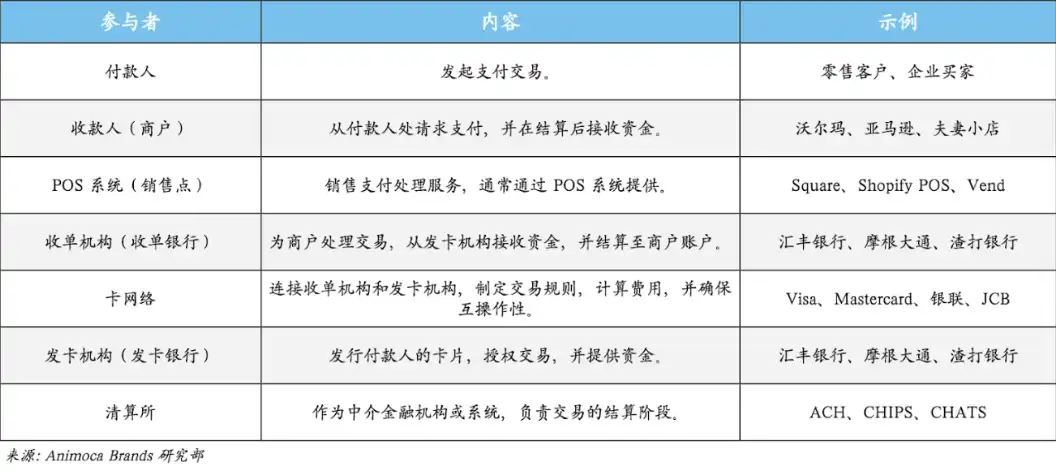
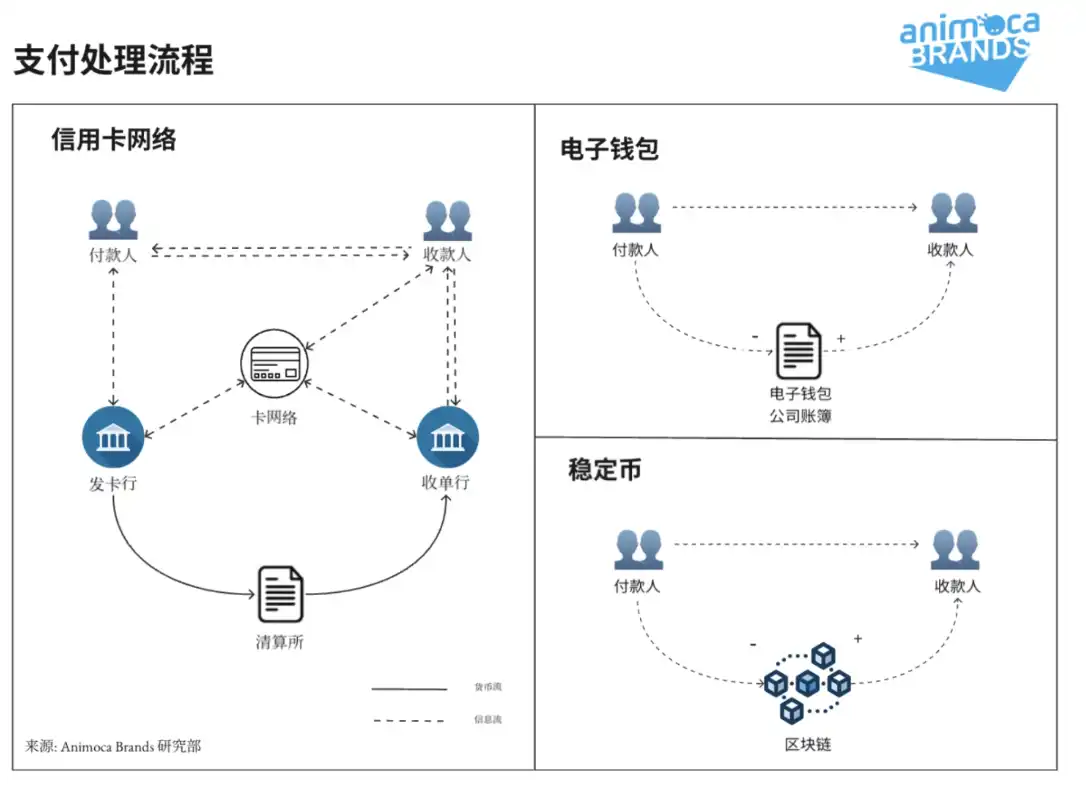
The existence of credit cards and card networks significantly enhances the convenience of non-cash payments, but they are often criticized for their high transaction fees. Each credit card transaction automatically deducts 2-3% or more from the amount paid by the customer as a fee. This fee can be a heavy burden for low-margin businesses.
However, upon closer examination, the card network itself is not the main cause of high fees. Credit card transaction fees can be roughly divided into three parts: the "assessment fee" paid to the card network, the "processing fee" for the sales terminal, and the "interchange fee" paid to the issuing bank. Among these, the fee charged by the card network is the least, only 0.15% of the transaction. For example, Visa processes $160 trillion in transactions annually, while its annual revenue accounts for only 0.2% of the total transaction volume. The bulk of the transaction fees goes to the issuing bank as the interchange fee (1-3%). This fee primarily covers the costs and risks associated with the services provided by banks, such as credit default risk and consumer protection. For consumers who need to use credit, this rate is not excessive. For issuing banks, credit cards, as a credit business with default risk, indicate that a 2% fee reflects the bank's expertise in risk management rather than inefficiency.
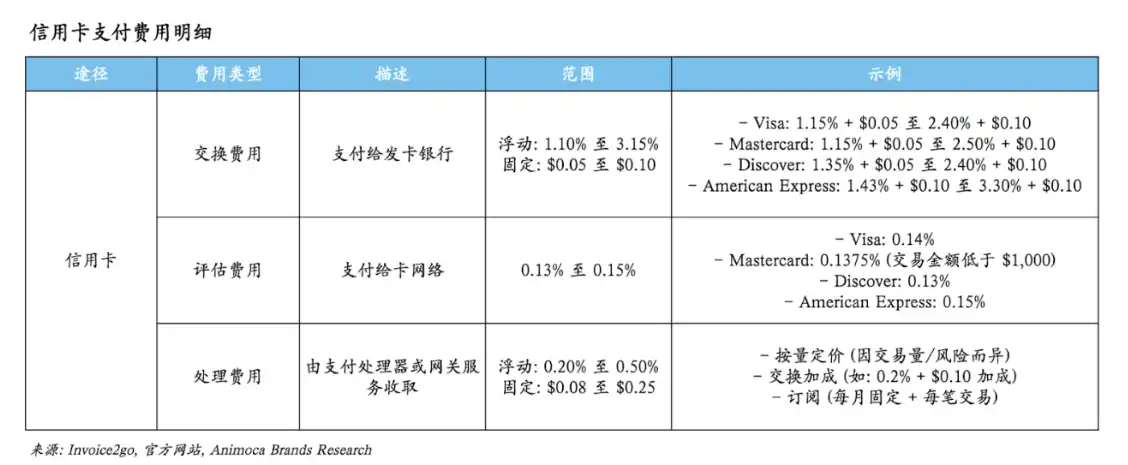
Therefore, the key issue with credit card fees is not their high cost, but rather that consumers have defaulted to choosing them; regardless of whether they need credit, they tend to prefer using credit cards over other options. The root cause of this consumer preference is the mismatch between the choice of payment method and the party bearing the costs: consumers choose the payment method, while merchants bear the transaction fees. This mismatch gives issuing banks room to operate, allowing them to use part of the fees to "bribe" consumers with rewards and points to gain their favor. This strategy is highly effective, as many consumers prefer credit cards for better cashback and points benefits over debit cards, cash, or digital wallets that do not offer points, even if they do not need credit.
In addition to high transaction fees, card networks also incur high cross-border fees during cross-border payments, further increasing transaction costs. The root of this problem lies in the reliance on traditional interbank paths for settlement between issuing and acquiring banks. We will discuss the topic of cross-border settlements in the transfer section.
From the above discussion, we can roughly understand the attitudes of the various parties involved in the payment system towards stablecoins:
Merchants are the most affected by the credit card system, thus having the strongest motivation to seek alternative solutions. Companies like Walmart, Amazon, and JD.com show strong interest in stablecoin payments as an alternative due to their extensive sales networks.
Card networks like Visa and Mastercard do not account for a large portion of transaction fees and can support various currencies, including stablecoins. Therefore, card networks are not inherently opposed to stablecoins. On the contrary, as more stablecoins enter everyday transactions, card networks may become more important due to their bridging function. Additionally, with stablecoins, the settlement process in payment networks can be simplified, allowing card networks to further participate in settlements and play a larger role in the overall payment process. Visa demonstrated the potential for cross-border settlements with issuers using stablecoins as early as 2021.
Terminal (POS) solution providers can expand their product lines by supporting new payment methods. Stablecoins will not disrupt their current roles; rather, they can provide terminal solution providers with opportunities to enter services such as acquiring and deposits/withdrawals. Stripe's acquisition of Bridge and Priv (wallet services) underscores this trend.
Stablecoin-Based "Open-Source Digital Wallets"
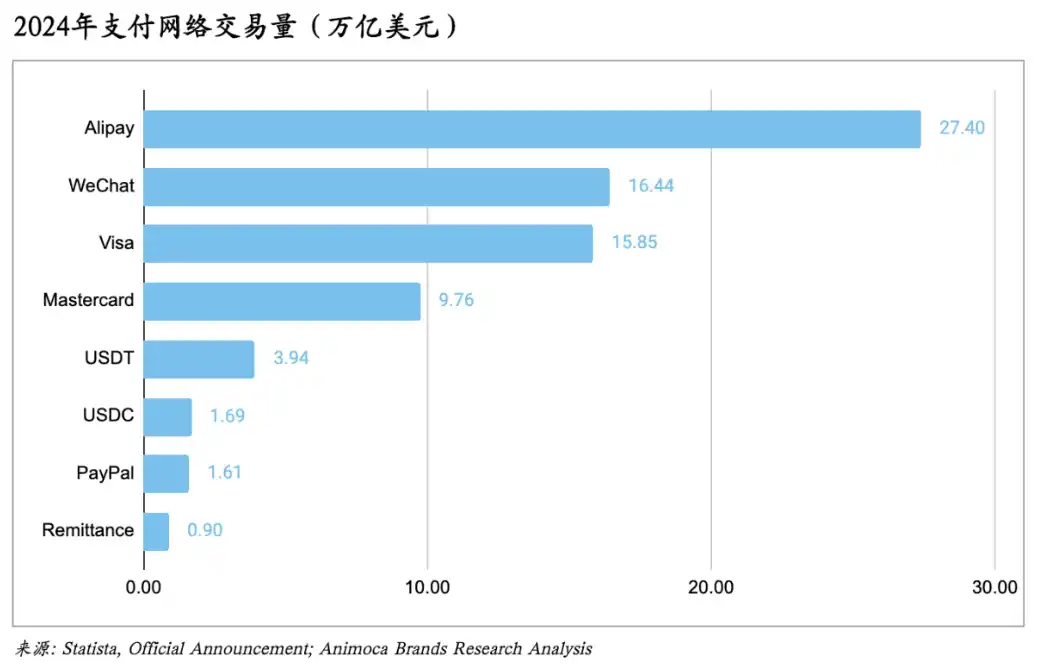
Digital wallets were first introduced by PayPal in the United States and have successfully dominated payments in China, as well as in many developing countries in Southeast Asia and Africa, years later. Compared to card payments, digital wallets offer several advantages, such as:
● Registering a digital wallet is much easier than opening a bank account. Users can start using a digital wallet by completing online registration, similar to signing up for a website. Some digital wallet services also provide offline channels for deposits or withdrawals.
● As a product from the Web2 era, digital wallets are inherently compatible with online transactions, which has led to a rapid increase in their application scenarios in the mobile era, gradually expanding to offline merchants.
● Due to fewer participating nodes in the payment process, the cost of digital wallet transactions is cheaper than those based on card networks. For example, Alipay charges merchants a fee of 0.6%, and peer-to-peer transfers between users are free.
Stablecoin payments share many similarities with digital wallets and can thus be considered a new form of digital wallet service. The similarities include:
● The "funds" in wallet accounts are all tokenized representations of fiat currency on the ledger, which must be maintained at 100% collateral as per regulatory requirements.
● Payments between digital wallets are simply transaction records on the ledger. However, digital wallet transaction records are on the proprietary ledger of the respective company (e.g., Alipay), while stablecoin payments are recorded on a decentralized blockchain ledger.
● In terms of user interface, the user interface and interaction methods of digital wallets and cryptocurrency wallets are basically the same, such as supporting features like "QR code payments" and "payment codes."
At the same time, stablecoin payments, due to their decentralized architecture, represent a more open "open-source digital wallet" compared to Web2 era products, for example:
● The issuance of stablecoins, which involves compliance, collateral, and contract deployment, can come from multiple institutions, commonly including Tether, Circle, etc.
● The deposits and withdrawals of stablecoins are provided by independent licensed institutions, such as Transak.
● The ledgers for stablecoin transactions can utilize different blockchains, such as Ethereum, Solana, TON, etc.
● Users can use any wallet that supports these blockchains for payments and receipts.
● Cross-wallet payments can be processed through various on-chain cross-chain protocols, such as LayerZero.
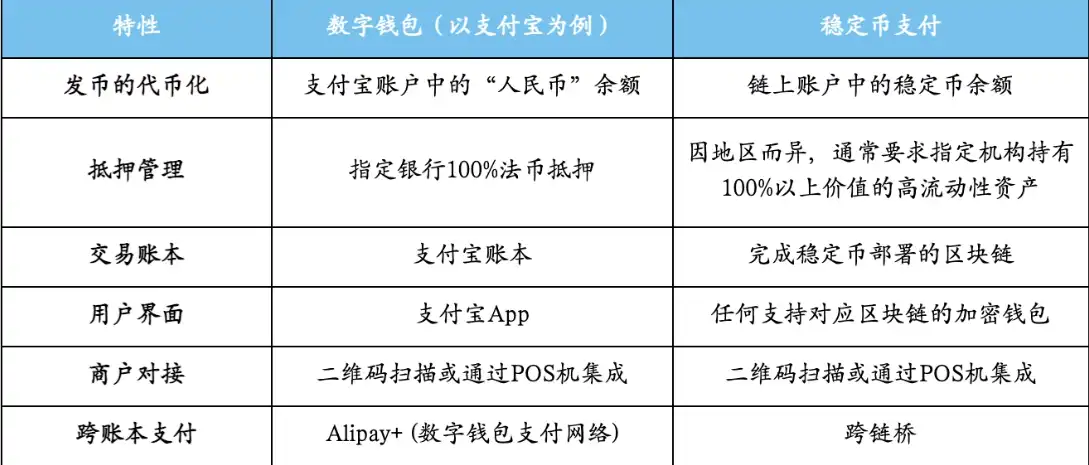
Therefore, in the process of promoting stablecoin payments, on one hand, they can draw on the successful strategies of digital wallets, while on the other hand, they can leverage their more open characteristics to enter areas that digital wallets previously could not conquer. For example:
● Capturing consumption scenarios: Digital wallets have acquired a large number of users by targeting applications with vast user bases and consumption needs. For instance, Alipay (e-commerce), WeChat Pay (social), Grab Pay (ride-hailing), and public transport payments like Suica, EasyCard, and Octopus. Stablecoin payments are likely to follow a similar path.
● Opportunities in developed economies: Stablecoin payments provide another opportunity to challenge the dominance of credit cards in developed economies like the United States. The open-source nature of stablecoins allows merchants, stablecoin issuers, blockchain operators, cryptocurrency wallets, and payment service providers to independently contribute to the stablecoin sector without the need for coordination, thus forming a collective force. This approach is much stronger than promoting a single digital wallet service (like PayPal) alone. Considering that 28% of the U.S. population already owns cryptocurrency, once major consumer platforms begin to support stablecoins, the user base will grow rapidly.
● Financial inclusion: Digital wallets have promoted financial inclusion by facilitating the conversion from cash to online payments and providing services like deposits and loans to underbanked populations. As an open-source digital wallet, stablecoins can further extend this trend by lowering technical barriers. Payment service providers in various countries do not need to engage in deep technical development; they only need to integrate local stablecoins with existing blockchain infrastructure and applications.
● Marketing advantages: Stablecoin payments will require extensive promotional efforts. This includes persuading merchants to accept new payment forms, upgrading point-of-sale (PoS) systems, and attracting users through incentives (such as discounts and rewards). In this regard, stablecoins can provide necessary funding for marketing activities since their circulation can generate interest through collateral.
● Card networks remain important: The popularity of digital wallets does not eliminate the need for intermediary networks in transactions. For example, digital wallets still rely on Alipay+ to connect merchants with different wallets; the Octopus app supports payments through UnionPay PoS, etc. Stablecoins will also require support from various payment networks. Existing payment infrastructures (such as Visa, Stripe, etc.) can expand their service offerings by adding support for stablecoins. For instance, Stripe has already acquired several crypto services to support the growing demand from merchants. Visa has also clearly expressed its vision to support digital currencies.
● On-chain payment networks: The on-chain aspect of stablecoin payments will also require routing and exchange services to support payments between stablecoins from different issuers or the same stablecoin across different blockchains. Circle's CPN (Circle Payment Network) has already enabled cross-chain routing and settlement for its own USDC. The further development of this demand will present new opportunities for traditional networks and on-chain native protocols.
Transfers
Interbank transfers are one of the pillars of the modern economy. Even though digital wallets can handle a large number of small transfers between individuals, most fund transfers still occur through banks. Due to their importance, every country and region establishes the necessary infrastructure (such as clearinghouses) to facilitate effective transfers within a country. However, due to the lack of clearinghouses for cross-border transactions, cross-border transfers remain relatively inefficient. The SWIFT telegraphic network, established in the 1970s, is still the cornerstone of interbank cross-border transfers 50 years later.
Domestic Transfers
Domestic transfers are the primary form of fund movement. In 2024, China's domestic payment system processed 12.45 trillion yuan (approximately $1.8 trillion) in transfers. Meanwhile, the amount processed domestically in the United States is also comparable.
These interbank transfers are typically facilitated by clearinghouse services provided by central banks or banking associations. Under the clearinghouse framework, banks do not need to settle directly with each other; instead, participating banks open accounts in the clearinghouse and execute transfers through transactions recorded on the clearinghouse ledger. In this process, there is no direct flow of funds between banks; rather, there are only deposits and withdrawals between the banks and the clearinghouse. Taking the systems in the United States and China as examples:
U.S. banks use multiple clearing services. The Federal Reserve provides FedWire and FedNow for large and small transfers, respectively. The Clearing House Association offers CHIPS and RTP as parallel products. Additionally, the ACH system, which has been in existence for over 50 years and is managed by Nacha (a nonprofit banking association), is still widely adopted by most U.S. banks due to its compatibility with older systems.
Chinese banks rely on the clearing systems provided by the People's Bank of China, including HVPS, BEPS, and IBPS, to manage transfers of varying sizes and time requirements. In Hong Kong, the Hong Kong Monetary Authority provides CHATS (Clearing House Automated Transfer System) for large interbank transfers and FPS (Faster Payment System) for instant fund transfers. This year, the "Cross-Border Payment Link" was launched, connecting the PBOC's IBPS and the HKMA's FPS to enable instant fund transfers between mainland China and Hong Kong, as well as currency exchange between the Hong Kong dollar and the renminbi.
Additionally, the People's Bank of China provides CIPS (Cross-Border Interbank Payment System) for offshore renminbi (CNH) transactions. Through CIPS, overseas banks can directly transfer renminbi to banks within China or other overseas CIPS participants without relying on the SWIFT system. In contrast, cross-border U.S. dollar transfers are primarily conducted through CHIPS, which can only be settled in New York. All dollar cross-border transfers require banks to first send dollars to their New York branches through internal and external transfers before proceeding with subsequent operations.
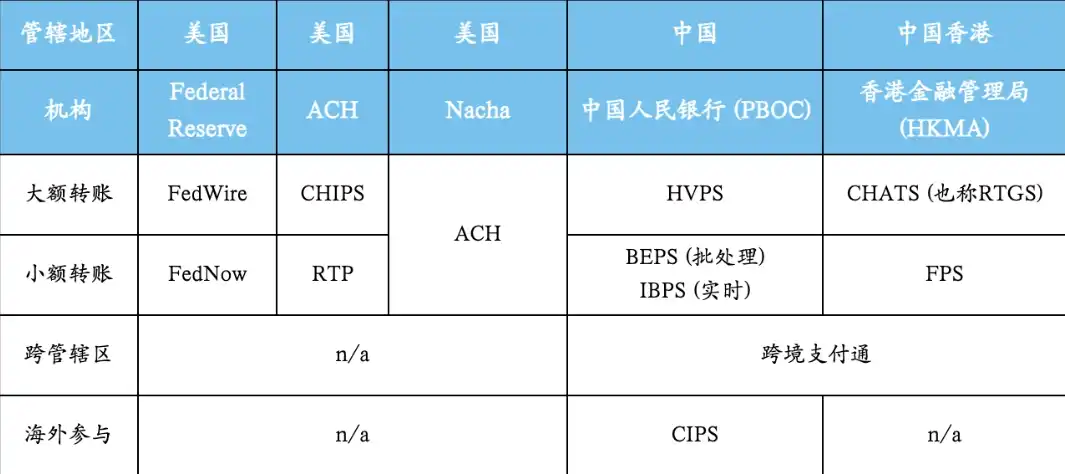
From the above analysis, it is evident that existing clearing systems can cover a wide range of transfer application scenarios, but they still have limitations:
● System fragmentation: Maintaining old systems and coordinating across banks is challenging, leading to the coexistence of multiple clearing services.
● Access barriers: Clearinghouses are typically limited to banks within a country and only support local fiat currencies. This is clearly insufficient for currencies that require global mobility.
● System availability: Many clearing systems do not support 24/7/365 operations. They often shut down services on weekends and evenings. Even 24/7 systems still require downtime for maintenance and upgrades.
● Cost and speed: Most clearing services operate on a batch processing basis, requiring trade-offs between cost and time.

Stablecoins can enhance transfer efficiency through two methods. The first is the previously mentioned digital wallet transfers, primarily targeting small transfers between users. The second is providing "open clearinghouse" services in interbank transfers. Let us elaborate on the concept of "open clearinghouses."
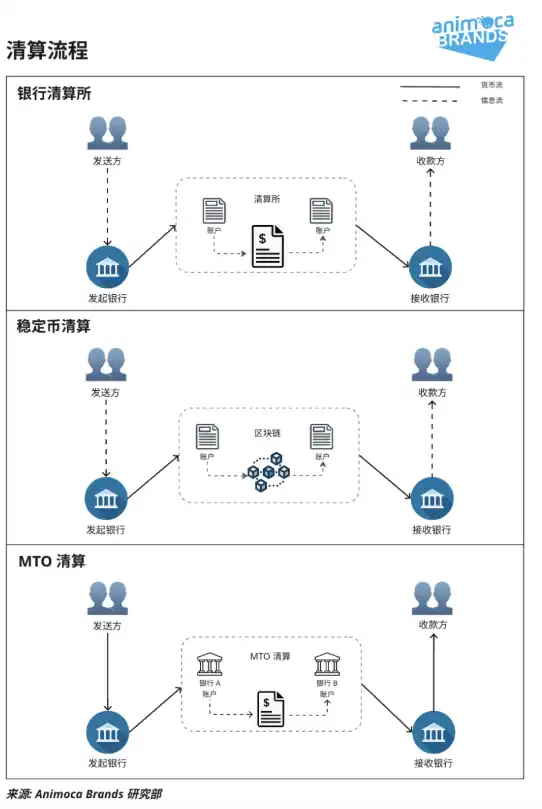
Transactions and settlements conducted through stablecoins share many similarities with clearinghouse processes. As illustrated in the flowchart, under the clearinghouse framework, banks create accounts and deposit funds on the clearinghouse ledger. Settlements between banks then become transactions recorded on the clearinghouse ledger. In contrast, settlements through stablecoins equate to banks establishing on-chain accounts and "depositing" stablecoins. Interbank transfers thus become transactions recorded on the blockchain ledger. Therefore, interbank payments realized through stablecoins can be viewed as a clearing service provided by blockchain and stablecoins.
At the same time, the clearing services enabled by stablecoins are more open compared to traditional clearinghouses. Stablecoin settlements can be achieved in a self-organizing manner between banks, free from jurisdictional or currency usage restrictions. Additionally, stablecoin settlements can integrate various DeFi functionalities of the blockchain, allowing for continuous expansion of clearing-related features.
Using stablecoin "open clearinghouses," the interbank transfer process can be improved in many aspects:
● Cost: Traditional clearing services incur high fees. For example, FedWire charges $0.20 per transaction, while FedNow averages about $0.045 per transaction. This is not a small amount under large-scale applications. In contrast, the transfer fees for most stablecoin transactions on blockchains are typically below $0.01.
● Speed: On-chain transfers are inherently real-time, with processing speed limited only by block generation time. Different blockchains have varying block generation times, generally ranging from 0.1 to 10 seconds.
● Availability: Major public blockchains are available 24/7 by default and do not require offline maintenance.
● Access: Major public blockchains are permissionless, meaning that clearing services are no longer constrained by country or currency. As more fiat currencies are integrated onto the blockchain, the types of supported currencies can continue to expand.
● Function Expansion: Traditional clearinghouses are usually managed by central banks or banking associations, making functional decisions in a top-down manner. This often leads to new features prioritizing commonly used functions, resulting in slow decision-making. In contrast, blockchain is inherently open to the functionalities needed by banks, effectively adding an "app store" for clearing services.
The role of stablecoins as "open clearinghouses" may be one of the main motivations for the four major U.S. banks to explore stablecoins. Pioneers can gain a first-mover advantage in setting standards (such as choosing blockchains and types of stablecoins). Moreover, given these banks' significant influence in the U.S. dollar ecosystem, their actions will impact the direction of subsequent innovations within this system. Considering the global role of the dollar, this dominant advantage will extend beyond the U.S. to influence the world.
Cross-Border Transfers
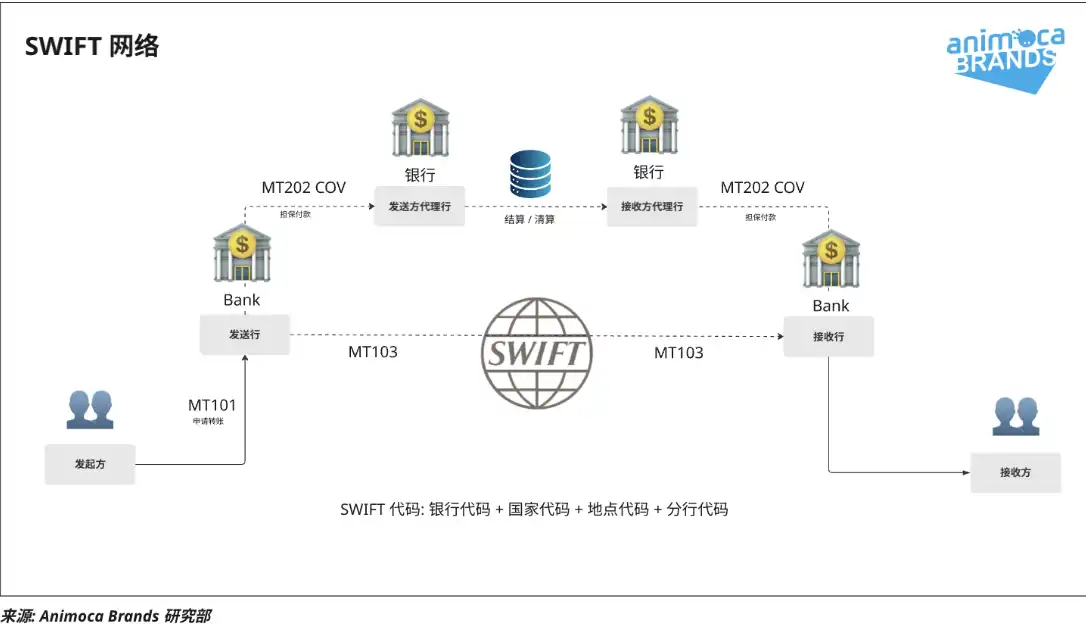
Cross-border transfers, or remittances, are smaller in scale compared to domestic transfers but are often criticized due to their high costs (approximately 5-6% of the transaction value), long processing times (about 5-7 business days), and unpredictable outcomes (transfers may fail without reason).
As mentioned earlier, the root cause of this inefficiency is the lack of cross-border clearinghouse services. This means there are deficiencies in two key functions of fund transfers:
Communication, which involves the remitting bank notifying the receiving bank of the transfer information.
Settlement, which is the transfer of funds from the remitting bank to the receiving bank.
In the absence of clearing services, the existing mainstream solution is wire transfers, also known as SWIFT transfers. This method separates the two functions as follows:
● Communication: Handled by SWIFT, which facilitates interbank communication and transmits transfer requests between the remitting bank, receiving bank, and intermediary banks.
● Settlement: Relies on interbank intermediaries, utilizing internal bank transfers and domestic clearing services in various countries (for example, U.S. dollars through CHIPS).
Taking a dollar transfer from Hong Kong to Brazil as an example, the approximate steps are:
Sending a message: A bank in Hong Kong sends a SWIFT telegram to a bank in Brazil, notifying it of the transfer information.
Choosing a path: The remitting bank in Hong Kong selects a settlement route and sends a SWIFT telegram to the intermediary bank.
Fund settlement:
- The remitting bank transfers dollars from its Hong Kong branch to its New York branch through internal settlement.
- The New York branch sends the funds to the receiving bank's New York branch via CHIPS.
- The receiving bank transfers the funds to Brazil through internal settlement.
Even in this straightforward case, the entire process takes 3-5 business days due to the need for daily settlements at each step, with fees accumulating at each intermediary point.
This transfer can become even more complex with the addition of other factors, such as:
● Using local currency: If the recipient in Brazil only accepts Brazilian reais and the remitter only has Hong Kong dollars, the remitter must first convert Hong Kong dollars to U.S. dollars to use the aforementioned fund transfer path, and then convert to Brazilian reais at the Brazilian bank.
● Small banks: Banks without a New York branch need to route through a larger bank with U.S. dollar processing capabilities, further increasing steps and costs.
In the traditional clearinghouse model, a country can also establish offshore clearing banks to allow non-domestic banks to participate in cross-border currency clearing (for example, CIPS for renminbi transfers), but these efforts are still limited to a single currency and a slow top-down expansion process. For instance, the vast majority (73%) of offshore renminbi transfers still rely on Hong Kong (equivalent to CHIPS through New York) and frequently use SWIFT rather than relying solely on CIPS.
Remittance Operators: Existing Improvements in Cross-Border Payments
Remittance operators (MTOs) are one innovative approach to addressing the inefficiencies of cross-border transfers. MTOs are widely used in international e-commerce and personal remittances. Companies like Western Union, Wise, and Airwallex are well-known brands in their respective regions and customer bases.
The role of MTOs is similar to a user-operated cross-border clearinghouse. Remitters deposit local currency into the MTO's local bank account and notify the MTO, effectively "depositing" into the MTO's ledger. The MTO then calculates the corresponding amount in the recipient's currency and pays the equivalent amount from a bank account in the recipient's country to the recipient's local account, completing the "withdrawal."
This method improves efficiency because it effectively avoids actual cross-border fund movement. The "cross-border" portion of each transaction is merely recorded in the MTO's ledger, and operations are conducted through the MTO's accounts in the sender and recipient's countries. Therefore, the main costs for MTOs are not related to cross-border transactions but rather to maintaining their liquidity pools in the service regions. In regions with balanced fund flows (e.g., between Singapore and Hong Kong), the liquidity pool is generally balanced and requires minimal maintenance. When liquidity pools are unbalanced (e.g., from the U.S. to Mexico), MTOs reduce the cost of transferring unit amounts through bulk transfers and currency exchanges.
However, despite their high efficiency, MTOs still handle only a small portion of the total cross-border transfer volume. Leading MTOs like Wise or Airwallex process less than $200 billion in transactions annually, generating about $1 billion in revenue. Reports indicate that the entire MTO industry has an annual revenue of $42 billion, so we estimate that MTO transfers account for about 3-5% of total cross-border remittance volume.
Several factors may explain why MTOs have not dominated the cross-border transfer market:
● Large organizations often prefer bank transfers for security reasons.
● Traditional wire transfer networks offer broader coverage, while MTOs typically only support popular destinations and currencies.
● Limited liquidity pool sizes may restrict MTOs from handling large transfers.
Additionally, MTOs incur extra operational costs, such as maintaining retail stores or corporate sales teams, which banks can amortize across their broader services.
It is noteworthy that cross-border transfers conducted through cryptocurrency exchanges (e.g., Bitso) are more based on the MTO model, where core transfers occur on the exchange's own ledger rather than utilizing the blockchain transfer capabilities of cryptocurrencies. Remitters deposit U.S. dollars into the cryptocurrency exchange's account, send stablecoins to the recipient's exchange account, and then withdraw to the recipient's local bank account. In this process, the cryptocurrency exchange only updates its centralized ledger and manages the inflows and outflows with local bank accounts. The existence of cryptocurrencies primarily provides an alternative means to fund accounts rather than serving as a component of the underlying transfer mechanism.
Stablecoins for Cross-Border Transfers: A New Way to Integrate MTOs and Banks
Stablecoins can integrate the MTO model into bank cross-border transfers. As mentioned earlier, stablecoins support the establishment of "open clearinghouses," enabling direct single-currency transfers between any banks, transcending geographical limitations. For example, a dollar transfer from Hong Kong to Brazil, which requires three intermediary stages via wire transfer, can now be achieved through a direct on-chain stablecoin transfer between two banks, taking only seconds and costing less than $1.
For transfers that require currency conversion (e.g., Hong Kong dollars to Brazilian reais), a simple solution is to first convert Hong Kong dollars to U.S. dollars or renminbi for stablecoin cross-border settlement. Then, after local withdrawal, convert to reais. This model represents a significant improvement over wire transfers. An even better method for cross-border transfers is to integrate currency conversion into the "open clearinghouse." Once both Hong Kong dollars and Brazilian reais have their own stablecoins, banks only need to conduct blockchain inflows and outflows in local currencies, while the conversion between Hong Kong dollars and Brazilian reais can occur through on-chain transaction liquidity pools. In this way, banks can participate in cross-border transfers without needing currency exchange capabilities, thereby expanding the range of participating banks. Of course, this model requires that all participating currencies are compliant stablecoins accepted by various countries, which may take time to achieve.
It is important to note that SWIFT, as the most widely accepted communication platform among global banks, will still play a key role in cross-border transfers. While stablecoins can significantly improve settlement processes, initiating transactions still requires a shared platform to communicate transfer details. Just as card networks will continue to exist alongside stablecoin payments, SWIFT can still fulfill its role in interbank communication within the world of stablecoins.
What Comes Next for Banks After Stablecoins?
The "open-source digital wallets" enabled by stablecoins may capture some retail business from banks. In the credit card market, primarily issued by banks, a market preference shift towards stablecoin payments may reduce credit card usage, thereby decreasing the revenue banks earn from card issuance. This may prompt banks to shift from issuing credit cards to providing consumer credit and protection services through integration with retailers or wallet applications. Additionally, personal deposits may increasingly appear on-chain in the form of stablecoins rather than as bank account balances, prompting banks to seek new ways to attract deposits, such as on-chain custody or RWA.
At the same time, bank infrastructure still has its advantages. For instance, central bank-supported clearinghouses provide ample liquidity for large instant settlements. In contrast, stablecoin transfers require pre-funding of on-chain accounts, so traditional clearinghouses may still have an edge in capital efficiency for large transfers. Furthermore, banks' key capabilities, such as lending, combined with their strong risk control abilities, remain indispensable for the modern economy. Finally, banks can still serve as gateways for users to access more financial and asset services.
A potential shift could see banks gradually moving their capabilities on-chain, whether through their own transformation or the emergence of new banks, similar to how banks transitioned from physical branches to online banking during the internet era. Users' bank accounts may evolve into on-chain IDs, with banks serving merely as custodians of on-chain assets. Recommended financial products from banks could shift from funds and wealth management to tokenized real-world assets (RWAs), and loan services could integrate into on-chain DeFi, incorporating banks' risk control and compliance capabilities.
Ultimately, the modern financial system is built around banks, with central banks responsible for creating money and commercial banks distributing and amplifying the money supply under regulation. Stablecoins bring new possibilities for banking services, forcing banks to adapt to new business models. Banks that fail to keep up with the trend may be eliminated, but the banking industry as a whole will continue to play a significant role in the world.
Conclusion
This article primarily focuses on the main scenarios and potential uses of stablecoins onshore, given that regulatory frameworks have been established in major economies. There are many more topics related to stablecoins, such as on-chain native stablecoins, interest-bearing stablecoins, other competitors to stablecoins (such as central bank digital currencies (CBDCs) or tokenized deposits), and the political demands driving stablecoins. We will explore these topics in future articles.
免责声明:本文章仅代表作者个人观点,不代表本平台的立场和观点。本文章仅供信息分享,不构成对任何人的任何投资建议。用户与作者之间的任何争议,与本平台无关。如网页中刊载的文章或图片涉及侵权,请提供相关的权利证明和身份证明发送邮件到support@aicoin.com,本平台相关工作人员将会进行核查。



